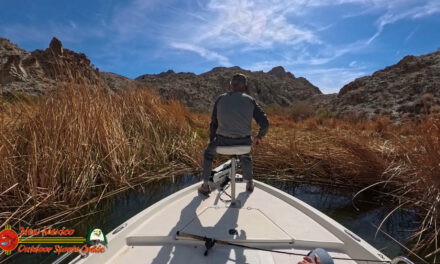JASPER, Texas — Favorable winters and high water levels have contributed to the spread of Giant salvinia (Salvinia molesta) in Toledo Bend Reservoir, one of dozens of lakes affected by exotic aquatic water weeds statewide. Infestations once confined to the backs of a small number of creeks and bayous in both Texas and Louisiana have now spread throughout the reservoir. Giant salvinia is easily spread overland to new locations by boat trailers, propellers, or even the intakes of jet-skis. The possibility of giant salvinia reaching neighboring Sam Rayburn Reservoir by this fall is extremely high, considering the number of boaters and anglers that utilize both reservoirs.
The threat giant salvinia poses to Sam Rayburn is very real and should be of primary concern to anyone who utilizes this premier bass fishery. Under ideal growing conditions in Texas, the invasive plant can double every 5-8 days, is resistant to cold weather, and can live for weeks out of water if kept moist. Once established, the invasive fern forms dense mats that eliminate all other aquatic vegetation in the area, introductions may be apparent as early as spring of 2005. Meanwhile, the potential threat to Sam Rayburn and many other popular reservoirs in Texas and Louisiana continues to grow.
The magnitude of the problem has reached such proportions that the Texas Parks and Wildlife Department is now forced to concentrate all control efforts near boat ramps and other access points in an attempt to simply contain the infestation to Toledo Bend.
TPWD has begun large-scale introductions of a bio-control agent in the form of a weevil that is totally dependent on giant salvinia throughout its life cycle. Although it may take as long as two years for reproducing populations of giant salvinia weevils to establish, results of these introductions may be apparent as early as spring of 2005.
Concerned anglers and other resource users can help by inspecting and cleaning their boats, trailers, jet-ski intakes, and other equipment of all aquatic vegetation before leaving an infected area. Anglers fishing Sam Rayburn should be aware of any suspicious floating aquatic vegetation, particularly around boat ramps and the backs of nearby creeks. Most new infestations of invasive species occur at or near boat ramps.
Giant salvinia typically has oblong floating leaves from .5 to 1.5 inches long. Leaves have a velvety surface and are usually a shade of green. Younger plants closely resemble common salvinia and have smaller leaves that lie flat on the water surface. In more mature plants the leaves are much larger, folded, and compressed into upright chains.
When viewed with a magnifying glass, the tips of leaf hairs on giant salvinia resemble an eggbeater. In contrast, leaf hairs of common salvinia are forked and do not form the identifying “cage-like” structure.
Common salvinia, a close cousin to giant salvinia, has been do*****ented on both Sam Rayburn and B.A. Steinhagen. Although a serious problem on B.A. Steinhagen, common salvinia persists in relatively small populations on Sam Rayburn primarily isolated to the Harvey Creek and Stanley Creek arms.
TPWD personnel, the Sabine River Authority, and the Louisiana Department of Wildlife and Fisheries (LDWF) have been waging a pitched battle with giant salvinia on Toledo Bend since its discovery in 1998. Aggressive herbicide treatments by TPWD and LDWF soon after its discovery held infestations in check for the first two years. An unplanned and extended drawdown in 2000 helped to suppress the invasive fern, stranding many plants on dry land. Lower water levels during the summer normally help contain the spread of giant salvinia, although small populations will continue to thrive in the backs of creeks and drainages.
Possession or transport of giant salvinia is prohibited by State and Federal law. Any possible sightings of giant salvinia on Sam Rayburn should be reported to TPWD immediately. Any suspicious plants found should be left in place and their exact location do*****ented. – Lake Mohave
– Lake Mohave






